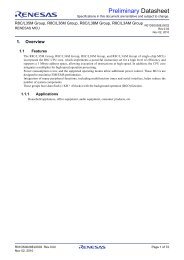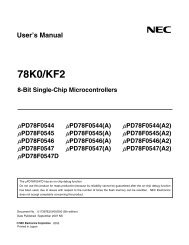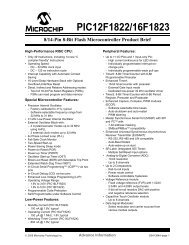xmega a3u - Elfa
xmega a3u - Elfa
xmega a3u - Elfa
You also want an ePaper? Increase the reach of your titles
YUMPU automatically turns print PDFs into web optimized ePapers that Google loves.
XMEGA A3U<br />
Table 7-2. Number of words and pages in the flash.<br />
Devices PC size Flash size Page size FWORD FPAGE Application Boot<br />
[bits] [bytes] [words] Size No of pages Size No of pages<br />
AT<strong>xmega</strong>64A3U 16 64K + 4K 128 Z[7:1] Z[16:8] 64K 256 4K 16<br />
AT<strong>xmega</strong>128A3U 17 128K + 8K 256 Z[8:1] Z[17:9] 128K 256 8K 16<br />
AT<strong>xmega</strong>192A3U 17 192K + 8K 256 Z[8:1] Z[17:9] 192K 384 8K 16<br />
AT<strong>xmega</strong>256A3U 18 256K + 8K 256 Z[8:1] Z[18:9] 256K 512 8K 16<br />
Table 7-3 shows EEPROM memory organization for the Atmel AVR XMEGA A3U devices.<br />
EEEPROM write and erase operations can be performed one page or one byte at a time, while<br />
reading the EEPROM is done one byte at a time. For EEPROM access the NVM address register<br />
(ADDR[m:n]) is used for addressing. The most significant bits in the address (E2PAGE) give<br />
the page number and the least significant address bits (E2BYTE) give the byte in the page.<br />
Table 7-3. Number of bytes and pages in the EEPROM.<br />
Devices EEPROM Page size E2BYTE E2PAGE No of pages<br />
size<br />
[bytes]<br />
AT<strong>xmega</strong>64A3U 2K 32 ADDR[4:0] ADDR[10:5] 64<br />
AT<strong>xmega</strong>128A3U 2K 32 ADDR[4:0] ADDR[10:5] 64<br />
AT<strong>xmega</strong>192A3U 2K 32 ADDR[4:0] ADDR[10:5] 64<br />
AT<strong>xmega</strong>256A3U 4K 32 ADDR[4:0] ADDR[11:5] 128<br />
8386B–AVR–12/11<br />
16
















